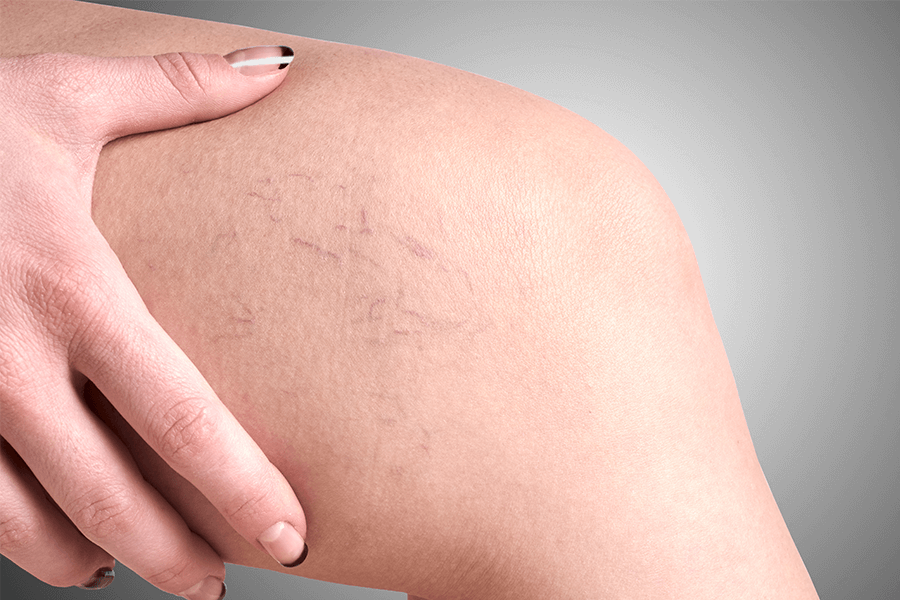If you have ever noticed a singular or patch of spider veins appear, you may be wondering what caused it, how you can treat it and how you can prevent more from coming! Keep reading to find out.
What are spider veins?
Spider veins are small, thread-like veins that appear on the skin’s surface and come in all different shapes, sizes and colours. These damaged veins can appear sparingly, webbed or in branch-like clusters and are often red, blue or purple.
They are most predominantly found on the legs, however, can appear anywhere on the body, including the face.
Although these veins are usually harmless, they can be indicative to underlying venous disease such as varicose veins. It is important to understand the dangers of not treating varicose veins.
If there are no underlying venous issues uncovered via ultrasound, then the treatment of webbed surface veins will mainly be for cosmetic reasons. These coloured veins can often make patients feel self-conscious to show their legs, making treatment vital for their own self confidence and happiness.
Difference between spider and varicose veins?
Varicose veins are veins that have become enlarged due to the pooling of blood forming as a result of damaged and weakened valves that would usually help regulate venous blood flow. These veins often appear twisted and bulging at the skin’s surface and will also appear below the skin’s surface as enlarged veins.
Whereas spider veins are the superficial, smaller, red, purple or blue veins that appear in a webbed or thread-like way. These veins can often be a flow on effect of hidden varicose veins or reticular feeder veins.
Causes of spider veins?
The causes of spider veins are not entirely understood. Sometimes, underlying venous disease will cause ‘feeder’ varicose or reticular veins to cause these surface veins.
What increases a person’s risk of development?
Some risk factors can be hormones, family history, pregnancy and weight gain.
It has also been observed that prolonged periods of standing can lead to venous issues and the development of these webbed veins. This is why teachers and hairdressers often present with both spider and varicose veins.
Can crossing legs cause increase risk?
Contrary to popular belief, crossing your legs has no effect on your risk of forming spider veins or varicose veins. However, prolonged periods of sitting still can negatively affect your venous health, whether that is cross legged or not.
Treatment of spider veins:
Sclerotherapy:
Sclerotherapy is the most effective treatment for spider veins. This is the process of injecting a sclerosant solution directly into the targeted vein. The solution causes the vein walls to collapse in on themselves and effectively shut off supply to the vein. The treated vein then breaks down and is absorbed into the surrounding tissue.
How long do sclerotherapy treatments take?
Sclerotherapy treatments are quick and easy, usually taking 30 minutes. These treatments are walk-in and walk-out, meaning you can even go straight back to work after the treatment.
Are sclerotherapy results immediate?
Yes, once the sclerosing solution enters the targeted vein it will, quite literally, begin to disappear right before your eyes! Some people may require more than one treatment to target all spider veins.
Does sclerotherapy hurt?
Local anaesthetic is used to numb the area prior to injecting. You may feel a slight pinch as the needle enters the vein; this pain subsides quickly as the solution enters. Patients report a small amount of discomfort during treatment, but no pain.
Compression stockings:
Medical grade compression stockings can help to improve overall circulation through reducing venous pressure. These stockings work by compressing the leg (strongest at the ankle and then easing up the leg), therefore squeezing the vein walls together slightly to ease the blood flow back up towards the heart.
Compression stocking can assist in preventing additional spider veins as well as reducing any associated symptoms such as swelling. By reducing the swelling, the visibility of these already appeared spider veins can be reduced.
Prevention:
Some people are predisposed to this condition, meaning despite measures to prevent these tread-like surface veins, they will still appear. That does not mean it isn’t worth trying!
If you are concerned with either Spider or Varicose Veins, contact our friendly team to find out more.

